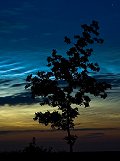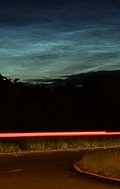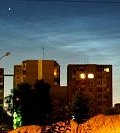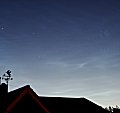| |
Observing
tips: Look
west 30 to 60 minutes after sunset when
the Sun has dipped 6o to 16o below the horizon.
If you see luminous blue-white tendrils spreading across the sky,
you've probably spotted a noctilucent
cloud. Although
noctilucent clouds appear most often at arctic latitudes, they have
been sighted in recent years
as far south as Colorado, Utah and Virginia. NLCs are seasonal,
appearing most often in late spring and summer. In the northern
hemisphere, the best time to look would be between mid-May and the
end of August. See also 2003,
2004, 2005,
2006 and 2007. |
 |
| |
| |
Photographer,
Location |
Images |
Comments |
|

|
Marek Nikodem,
Szubin, near Bydgoszcz, Poland
Jun. 26, 2008 |
#1,
#2, #3,
#4, more |
A very bright
and wonderful display of Noctilucent clouds tonight. So
very beautiful and it is fascinating to see the movement
of the "clouds", different structures and shapes. 26 June,22.50-23.50
local time
Photo
details: Nikon
D50 camera, ISO 200-400, exp 3-15 sec, |
|

|
Vladimir Ladinsky,
Voskresensk, SE of Moscow, Russia
Jun. 26, 2008 |
#1,
#2,
more |
It was first
appearance of NLC in the Moscow sky of 2008 season. Very
bright and very low at my sight. It expanded from North
to East during 2 hours and disappeared on the bright early
morning sky.
Photo
details: Canon
310D 18/4,5 15'' at ISO200 |
|

|
Oleg
Pomogaev,
Moscow, Russia
Jun. 25, 2008 |
#1,
#2, #3 |
Very
bright NLCs in the Moscow sky.
Photo
details: Canon
A710 IS digital camera on the tripod. IS0 200, exposition
from 2 to 8 seconds. |
|

|
Martin Mc Kenna,
Maghera, Co. Derry, N. Ireland
Jun. 27, 2008 |
#1,
#2,
#3,
#4,
more |
I heard there
were NLCs tonight, however, at first the unsettled N.Ireland
weather provided me with nothing more than an overcast sky.
I got rewarded after midnight when the sky suddenly cleared
and revealed an eye catching type 5 NLC display. This was
a definite shadow caster which showed off intense silver,
white and blue colours. The most complex region was the
intricate bands in the NW section which cast shadows onto
the background veil creating an amazing 3-d effect!. I was
very lucky to catch this one.
Photo
details: Fujifilm S6500fd 6.3MP at ISO100 2.5-5
sec exp. |
|

|
Alexander
Mednick,
Dniepropetrovsk, Ukraine.
Jun. 26, 2008 |
#1 |
Photo
details: Olympus C760UZ, 200 , ASA, 6s exposure.
|
|

|
Aurimas,
Vilnius, Lithuania.
Jun. 25, 2008 |
#1,
#2, #3 |
Bright
NLC clouds in Vilnius. It is the first time I've seen them
this year. |
|

|
Pete
Lawrence,
Selsey, West Sussex, UK (Latitude 51N)
Jun. 26, 2008 |
#1 |
After
reading the SpaceWeather alert on the evening of the 25th
June, I was a little more vigilant than usual about watching
out for NLCs. Of course nothing appeared during my watch
period and then, as I was packing up ready for bed, there
they were, delicately held above the north-eastern horizon.
Lots of structure visible including some odd 'holes' punched
in the clouds themselves. Lots of photos taken but I'm going
to bed before I look at any more of them! |
more
images (June 26): from
Roman White of Poltava, Ukraine (49.6N); from
Oleg Pomogaev of Moscow, Russia;
|
|
|








